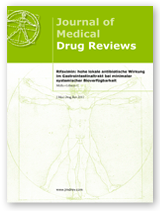
Das Journal of Medical Drug Reviews ist ein "Open Access"-Journal. Alle Artikel können für die persönliche Information des einzelnen Nutzers kostenlos heruntergeladen werden. Hingegen ist für eine kommerzielle Nutzung der Inhalte dieses Journals in jedwedem Medium die schriftliche Genehmigung des Verlages zwingend erforderlich. Das Urheberrecht liegt ausschließlich beim Verlag Reprint Publications GmbH & Co. KG.
© Reprint Publications 2016,
Webdesign Bothgrafik,
Programmierung amr
Ranolazin: Effektiv bei makro- und mikrovaskulär verursachten Angina pectoris Beschwerden durch direkte Wirkung im ischämischen Myocard
J Med Drug Rev 2013;3:5-15ABSTRACT
Hintergrund:
Viele Patienten mit Angina pectoris haben trotz maximal dosierter Standardtherapie (Beta-Blocker, lang wirksame Nitrate, Calcium-Antagonisten) oder trotz erfolgreicher Koronar-Revaskularisierung weiter Ischämie-Symptome. Da häufig primäre Störungen der Mikrozirkulation vorliegen, die durch Verbesserung der Makrozirkulation nicht beseitigt werden können, steht mit Ranolazin eine Substanz im Fokus der antianginösen Therapie, die eine direkte Wirkung im ischämischen Myokard entfaltet. Ranolazin wirkt im zellulären Bereich durch Hemmung des pathologisch erhöhten späten Natriumeinstroms und der konsekutiven Calcium-Überladung, ohne die Makro-Hämodynamik (Blutdruck, Herzfrequenz) wesentlich zu beeinflussen.
Ergebnisse:
Ranolazin wurde in einem umfangreichen klinischen Studienprogramm bei Patienten mit Angina pectoris sowohl als Monotherapie als auch als Add on zu klassischen antianginösen Substanzen untersucht. Die Monotherapie mit Ranolazin 500/1000/1500 mg jeweils zweimal täglich verlängerte die Belastungsdauer signifikant versus Placebo (MARISA-Studie). Die ERICA-Studie demonstrierte eine signifikante Reduktion der Zahl der wöchentlichen Angina pectoris-Attacken mit Ranolazin (1000 mg zweimal täglich) als Add on zu Amlodipin (10 mg/Tag). Bei Patienten mit sehr häufigen Angina pectoris-Attacken war der Ranolazin-Effekt besonders ausgeprägt. In der CARISA-Studie erhöhte Ranolazin (750 mg oder 1000 mg zweimal täglich) die Belastungsdauer und die Zeiten bis zum Auftreten von ST-Senkungen im EKG und reduzierte die Zahl der wöchentlichen Angina pectoris-Attacken bei Patienten mit Atenolol-, Amlodipin- oder Diltiazem-Basistherapie. Auch bei Patienten, die bereits die maximal verträgliche Basistherapie-Dosis erhielten, senkte Ranolazin als Add on die Zahl der wöchentlichen Angina pectoris-Attacken signifikant und erhöhte die Belastungsdauer. Darüber hinaus ist Ranolazin auch bei Angina pectoris-Patienten mit Typ 2 Diabetes mellitus in vergleichbarer Weise effektiv.
Bei Patienten mit ACS ohne ST-Streckenhebung (NSTE-ACS) und Angina pectoris-Symptomatik reduziert Ranolazin die Angina pectoris-Symptome und die Zahl wieder auftretender Ischämien (MERLIN-TIMI 36-Studie). Bei den Endpunkten kardiovaskulärer Tod und Myokardinfarkt schnitten Patienten, die Ranolazin plus Standardtherapie erhielten, tendenziell besser ab als Placebo plus Standardtherapie-Patienten. In der Subgruppe der Patienten
mit NSTE-ACS, stabiler Angina pectoris in der Anamnese und perkutaner Koronarintervention senkte Ranolazin darüber hinaus signifikant die kardiovaskuläre Mortalität.
Eine Cross over-Pilotstudie dokumentierte bei Patienten mit chronischer Angina pectoris ohne (!) nachweisbare Stenosen in drei der fünf Subskalen des Seattle Angina-Fragebogens (SAQ) Verbesserungen mit Ranolazin versus Placebo. Bei Belastung führte Ranolazin zu einem tendenziell höheren mittelventrikulären myokardialen Perfusionsreserve-Index (MPRI). In einer weiteren Pilotstudie wurden unter Ranolazin Verbesserungen der Myokard-Perfusion und der Belastung durch Ischämien bei Angina pectoris-Patienten nachgewiesen.
Schlussfolgerungen:
Durch den kausalen, antiischämischen Wirkansatz von Ranolazin können wiederkehrende Angina pectoris-Beschwerden hämodynamisch neutral reduziert werden, unabhängig von der zugrunde liegenden Ursache. Die Wirkweise von Ranolazin unterscheidet sich dadurch grundlegend von allen klassischen, antianginösen Therapeutika, die über die Hämodynamik wirken.
Schlüsselwörter: Angina pectoris, Ranolazin, Nitrate, Calciumantagonisten, Mikrozirkulationsstörungen, Koronarstenosen, kardiovaskulärer Tod, mikrovaskuläre Dysfunktion
Ranolazine
Effective in macro- and microvascular caused angina pectoris complaints by direct effects on the ischaemic myocardium
ABSTRACT (Review in German language)
Background: Many patients with angina pectoris further develop ischaemic symptoms despite maximally dosed standard treatment (beta-blockers, long-acting nitrates, calcium-antagonists) and despite successful coronary revascularisation. As frequently primary microvascular disorders not treatable by macrovascular improvements are present, ranolazine – a substance with direct effects on the ischaemic myocardium – are in the focus of antianginal therapy. Ranolazine exerts its efficacy on the cellular level by inhibition of the pathologically increased late sodium current und the subsequent calcium overload without a relevant influence on the macro-hemodynamic (blood pressure, heart rate).
Results: Ranolazine was investigated by an extensive clinical study programme in patients with angina pectoris as monotherapy and as add-on therapy together with classical antianginal drugs. Ranolazine 500/1000/1500 mg twice daily monotherapy prolonged exercise duration significantly versus Placebo (MARISA study). The ERICA study demonstrated a significant reduction of the number of weekly angina pectoris attacks with Ranolazine (1000 mg twice daily) as add-on to amlodipine (10 mg/day). In patients with very frequent angina pectoris attacks, the effect of ranolazine was particularly pronounced. In the CARISA study, ranolazine (750 mg or 1000 mg twice daily) increased exercise duration as well as the time until ST depression in ECG and reduced the number of weekly angina pectoris attacks in patients on atenolol, amlodipine or diltiazem background treatment. Also in patients receiving the maximally tolerated dose of the background therapy, ranolazine add-on reduced the number of weekly angina pectoris attacks significantly and increased the exercise duration. In addition, ranolazine has been shown to be effective in a similar way in patients with type 2 diabetes.
In ACS patients without ST-elevation (NSTE-ACS) and angina pectoris symptoms, ranolazine reduced angina pectoris symptoms as well as recurrent ischaemic events (MERLIN-TIMI 36 study). Patients receiving ranolazine plus standard treatment showed a trend toward better outcomes regarding the endpoints cardiovascular death and myocardial infarction compared with patients receiving placebo plus standard treatment. In the subgroup of patients with ACS, a history of stabile angina pectoris and percutaneous coronary intervention, ranolazine additionally reduced the cardiovascular mortality.
A cross-over pilot-study documented in patients with chronic angina pectoris without (!) detectable stenosis in three of five subscales of the Seattle angina questionnaire (SAQ) improvements with ranolazine versus placebo. During exercise, ranolazine treatment resulted in a trend towards higher middle-ventricular myocardial perfusion reserve index (MPRI). Another pilot study demonstrated with ranolazine improvements of the myocardial perfusion and the ischaemic burden in patients with angina pectoris.
Conclusions: Due to the causally, antiischaemic mode of action of ranolazine, recurrent angina pectoris symptoms can be reduced hemodynamically neutrally independently of the pathophysiological reason. Therefore, the mode of action of ranolazine differs basically from all classical antianginal therapeutics being effective by influencing hemodynamics.
Key words: angina pectoris – ranolazine – nitrates – calcium antagonists – microcirculatory disorders – coronary stenosis - cardiovascular death – microvascular dysfunction

